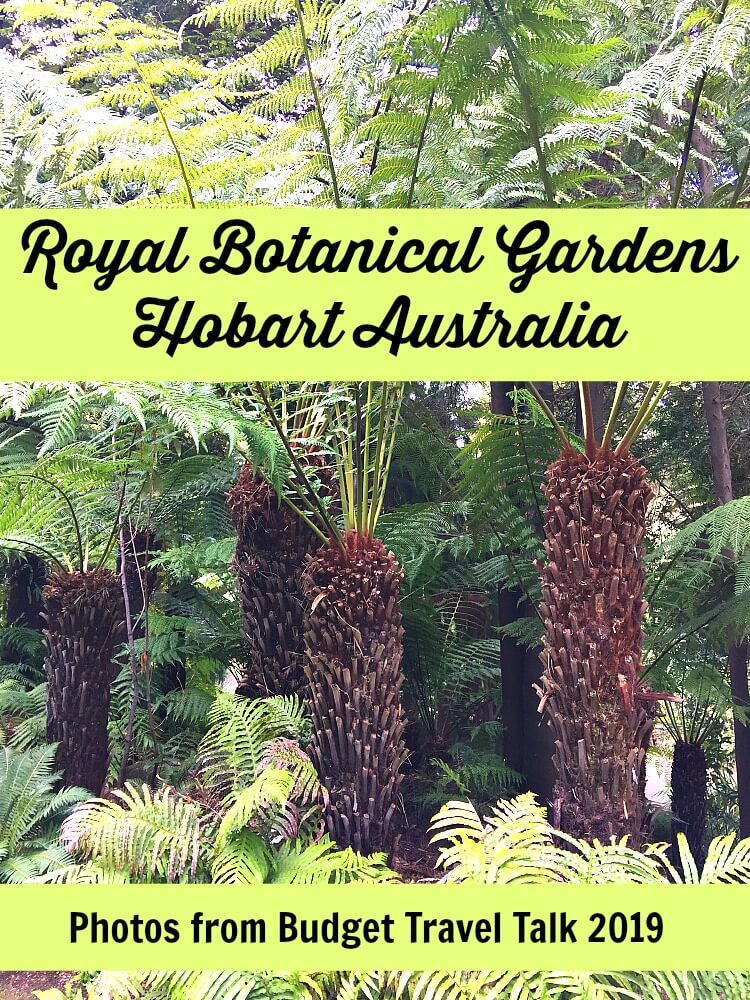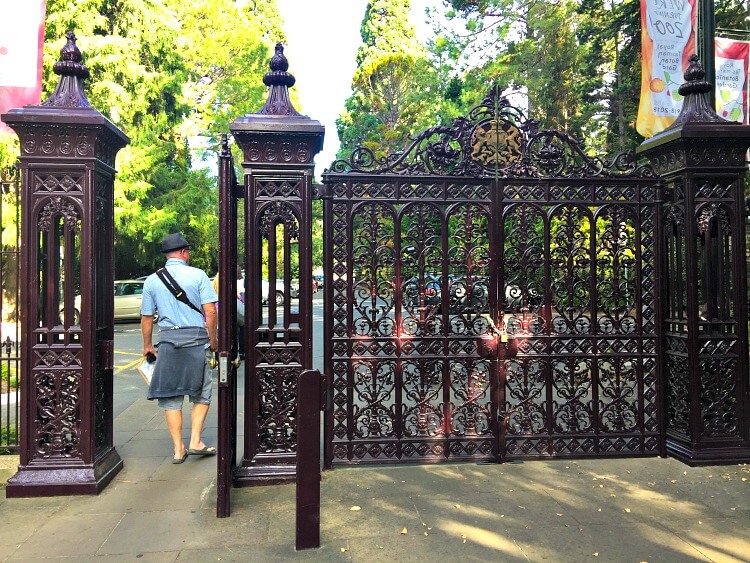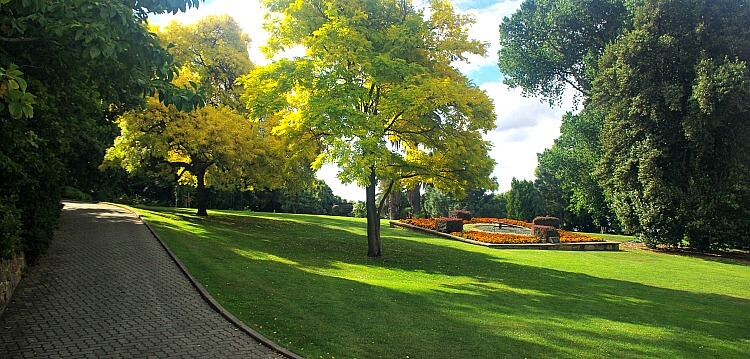A visit to the Hobart Botanical Garden in Tasmania, is as colourful as a flower, as other-worldly as a Subantarctic Island and as simple as a picnic on the grass. The Gardens are one of the many fun things to do in Hobart.
We arrived on the heels of a return road trip from Hobart to Bruny Island and a relaxed walk around the garden was just what the Doctor ordered.
Public Gardens are a real bonus for Budget Travellers. They are beautifully landscaped and they’re free. They are peaceful, historically interesting and if you’re travelling with children, what better place is there to burn their unlimited energy and have fun at the same time.
An extra bonus is being able to bring your own food. Pack an esky (food cooler) and leave it in the car until it’s time.
Picnics and Gardens are a match made in heaven.
In addition to 14 hectares of colour and foliage to explore, historical structures are sprinkled throughout the garden. A highlight for us was the veggie garden from TV show Gardening Australia.
Shortly after entering through the main entrance on Lower Domain Road we were met by an enthusiastic garden volunteer near The Hub. He gave us a rundown of the garden highlights and sent us off on our chosen route, clutching the free visitors guide/map. Brochures are season relevant, this one being “Autumn in the Gardens”.
Entrance to the Royal Botanical Gardens Hobart is free, but being a registered charity a gold coin donation is appreciated.
Hobart Royal Botanic Gardens location is in Queens Domain, known more simply as The Domain. North-east of the CBD, the Domain has been declared public property since 1860, but the Muwinina aboriginal people are the original owners. Excavations have revealed Aboriginal Artifacts dating back 5000 years.
Hobart Botanical Gardens Events
Major Hobart Botanical Gardens events include concerts, performances and exhibitions. After our visit “Day on the Lawn” was held at the Hobart gardens, featuring artists like Birds of Tokyo, Spiderbait and Kingswood. The Gardens Facebook page is a good place to find out what events are coming up.
Smaller events like weddings are also popular but need to be pre-approved.
Historical Structures
With your trusty map in hand you are primed to learn all about the garden.
You don’t have to be a History Nerd to enjoy locating the historical structures in the garden. I’ve listed them in this section, so you know what to look out for, but you can read more detail in “Things to See”.
Start with the beautiful old main iron entrance gates and shortly after leaving the Hub find the heritage listed Caretakers Cottage.
The repurposed Anniversary Arch arrived on site in 1968 but had a long and interesting life in another part of town before that.
Keep an eye out for Arthur Wall, convict built in 1828. It’s between the Lower Domain Road and the Subantarctic House and showcases early horticultural technology design. It forms the boundary of the entrance carpark so can be seen on the way in.
The red brick Eardley-Wilmot wall running across the garden from behind Pete’s Patch and up to the Admin building was convict built in 1840 by authority of the then Governor Eardley-Wilmot. It was controversial from the start, thought to be a frivolous waste of money. The Governor didn’t endear himself to the public by announcing the wall’s purpose was to “keep grasshoppers out”.
I wonder if the residents thought grasshoppers was code for them?
Things to see at Hobart Botanical Gardens
Whether here to learn about flora, historical structures or stroll hand in hand, there is something for everyone within Australia’s second oldest Botanic Gardens.
We toured them in an clockwise direction from the main gate.
Friends of the Garden Guided tours are no longer available, but Hobart Botanical Garden are trialling their own guided tours in Summer 2019.
As of our publishing date there were no Guided Tour Apps available.
Hobart Botanical Gardens Map with our route marked.
The Main Entrance Gates
I do love historic garden gates. This photo shows Marty leaving through them. Arthur Wall is on the left in the carpark.
In 1830 the entrance was just the one (still there) small door in the Arthur Wall, but that was remedied in 1878 with the arrival of new cast iron gates from England.
Decorated with gods, grapes and the Coat of Arms of the Royal Society they make a suitably impressive entrance for Royal Botanic Gardens.
The Hub
The Hub Information centre is located just inside the main gate.
The Gatekeepers Cottage
Start in a clockwise direction and you will see the Gatekeepers’ Cottage on the right of the path and down a little. Built in 1845 as a Superintendent’s residence it has been used by Caretakers, Gatekeepers, Porters and as Tearooms, but never once to house a Superintendent.
The cottage was added to in an ad hoc manner, before being returned to it’s original state in 1999.
The Gatekeepers Cottage is now heritage listed.
Chinese Collection

On the way to the Lily Pond check out the Chinese Collection. Hobart Botanical Garden is the only place in Australia where some of these plants are found.
They were all collected in 1992 in Yunnan Province near the border with Tibet.
This photo shows an Acer Maple Tree with Statue from the Hobart Royal Botanic Gardens Chinese Collection.
The Lily Pond
The Lily Pond is right up there as a Botanic Garden highlight. It can be viewed from above shortly after leaving the Caretakers Cottage. Take your time walking down to the Bicentennial lily pad decks which were incidentally opened by royalty in the form of Prince Edward in 2018. The surrounds of the lily pond are as important as the pond itself.
We spent a lot of time at the Lily Pond and couldn’t resist coming back for a second look.
The Pond was the original reservoir of 1848 collecting rainfall from the Domain. It progressed to being a home for water loving plants surrounded by towering conifers.
The white timber bridge and circular Lily Pad platforms provide overwater viewing areas while walkways and photo-worthy scenes appear magically on cue.
Tasmanian Native Collection and Fernery
Constructed in 1964 the original Fernery was upgraded with a watercourse in 1974. This garden revised my previous crazy idea that ferns are a tropical thing. I guess you can tell I’ve spent most of my life living in North Queensland.
Other non-fern natives are north of the Fernery extending toward Domain Highway, but we didn’t go that way.
Visitor Centre, Succulent Restaurant, Sprout Cafe, Botanic Shop
The Visitor Centre is toward the middle of the garden close to the Lily Pond. Hobart Botanical Gardens Cafe is appropriately named Sprout Cafe and opens to the rear courtyard, as do the foyer and Botanical Shop.
View from the Front of the Visitors Centre.
The deck of Succulent, the Botanical Gardens Hobart Restaurant, takes in some equally succulent views. Open 7 days 9.30 am to 3.30 pm, Succulent Restaurant Hobart has three separate menus, namely All Day Breakfast, Signature Menu and Desserts and Cakes.
I noticed that the clientele seemed to be people coming here just to dine, rather than garden goers.
Non-diners can see the view through the central foyer windows.
The visitor centre is the place to go for a sit down meal, food and drinks to go, souvenirs, potted plants and views over the park. We do not usually spend big on souvenirs, but purchased several at the Botanical Shop before regrouping outside for a coffee.
Anniversary Arch and Wollemi Pine
Anniversary Arch
The romantic carved Anniversary Arch sits below the wide garden staircase leading from the Lily Pond and Visitors Centre level. Built in 1913, it originally framed the front of the AMP building in Elizabeth Street. After the building was demolished, the Arch was donated to the Royal Tasmanian Botanical Gardens. The Arch was re-erected at it’s current position in 1968 in time for the 150th Anniversary of the garden.
Wollemi Pine
Nearby the Arch is a planting of Wollemi Pines, one of the strangest looking pine trees I’ve seen. Thought to be extinct on the planet, Australian David Noble found a stand of them in a Wollemi National Park gorge 200 km north west of Sydney Australia in 1994. The discovery has been likened to finding Dinosaurs alive today. Just Wow.
Today there are 100 mature trees in the wild but a Wollemi Recovery Plan now propagates and releases them world wide.
The tree was named after the location it was found and David Noble, aka Wollemia Nobilis.
Continue walking down toward the Floral Clock.
Floral Clock
The clock is situated at the top of a grassy bank and can be viewed either up close or from a distance below as the land drops away toward the centre of the garden before rising again.
The Floral Clock was installed in December 1968 for the 150th Anniversary of the Garden.
From the Clock, swing across to the front of the visitor centre. The views up to and back from the Visitors Centre are sweeping.
Tasmanian Botanical Gardens Conservatory
There are toilets here at the Visitors Centre but we are making a beeline to the Conservatory.
Not to be confused with the Tasmanian Food and Wine Conservatory in Devonport some 280 km north!
Foxgloves line the walkway into the 1939 Conservatory building which houses orchids and ornamentals in beds and baskets. It’s the perfect place to relax or avoid bad weather.
The fountain is hiding. Can you find it?
The walls were built from sandstone salvaged from demolished sections of Hobart General Hospital. This makes me love it even more.
Foxgloves and historic sandstone blocks.
The Conservatory is popular for weddings and corporate functions.
Tasmanian Community Food Garden or Pete’s Patch
Detour from the Conservatory to the Tasmanian Community Food Garden. Although it’s name has changed several times, the food garden has been growing produce for more than 200 years.
Back in 1806 it was Hangan’s Farm and thereafter formed part of Government House gardens.
The Eardley-Wilmot Wall can be seen as a right angle toward the back of the garden. The right hand section heads up toward the Admin Centre.
Prior to Peter Cundall retiring from Gardening Australia the garden was known as Pete’s Patch. Peter recently attended a celebration in the patch for his 90th birthday.
Today Tino Carnevale uses the food garden for his regular weekly feature on Gardening Australia.
The Food Garden uses organic principles.
Eardley-Wilmot Wall and Flowers
Leaving Pete’s Patch pass the Fuchsia House, Rose Arbour and continue through the Eardley-Willmot Wall to the French Explorer’s Garden and Japanese Garden. The Botanic Garden is closest to the river at the Japanese Garden, yet I didn’t notice that at the time.
This red brick wall summons images of romantic romps through arches and photo shoots where haughty models lounge on it’s buttresses.
Eardley-Wilmot Wall adds loads of interest and form to the garden and doesn’t it look magnificent with the afternoon sun on it!
Flower lovers should head to the Friends Mixed Border and Rose Arbour west of the wall. Other flower spots are back at the Caretaker’s cottage, around the Lily Pond and of course the Flower Clock.
This mass planting of Windflowers at the Lily Pond were my favourites. They are so pretty and precise that they don’t look real.
Governor Eardley-Wilmot fell out with the Royal Society of Tasmania and created general angst. He did however build this beautiful 4 metre tall brick wall extending 280 metres north/south across the garden.
Eardley-Wilmot fell out with the public by refusing to use unemployed but capable free-men to build the wall, opting for more affordable convict labour.
The path leads through the only original straight sided opening in the wall.
In 1964 further land was acquired for the French Explorers Garden and Japanese Garden and this is when the romantic archways appeared. I actually like the arches.
French Explorer’s Garden
I was somewhat surprised to see a garden dedicated to French Explorers in Hobart, but I’ve since learned they played a significant role in Tasmanian history.
The main exhibit is a fountain sculpture made from Huon Pine resembling the sails and bones of a french sailing ship.
The garden was built in 1972 and as a nod to those first French explorers, the plants are the same as those collected by the early explorers.
Huon pine is rot-resistant timber much prized for boat building. In an interesting twist, the Huon Pine tree, is named after the French Explorer Jean-Guillaume Huon de Kermadec.
It comes from North-West Tasmania where some individual trees are 1000 to 2000 years old. But they have been growing there as a species for 10,500 years. Read more about them here.
You can see live Huon Pines in the Tasmanian Collection and Fern House.
Japanese Garden
Opened in 1987, this garden was designed by Kanjiro Harada, a landscape designer from Hobart’s Japanese sister-city Yaizu and incorporates the three stalwarts of Japanese garden design – Wood, Water and Stone. Most of the plants are from Japan including the Japanese Maples whose leaves add beautiful Autumn colour. Conversely in Winter their bare branches take on a sculptural look.
A zig zag bridge crosses the pond in the Japanese Garden. Wood and Water design elements.
If you’re here in Spring expect Cherry Blossoms and in Summer, flowering Irises and Water Lilies.
I’m not alone in being a Japanese Garden lover and this is one of the most popular garden displays at the Hobart Botanical Garden. It’s more or less at the end of the garden road, so is somewhat secluded and contemplative.
Stone is a vital element in Japanese garden design.
As you can imagine the Japanese Garden is popular for wedding photographs.
Cactus Collection and Subantarctic Plant House
From the Japanese Garden backtrack past Pete’s Patch and the Cactus Garden, bypassing the Administration building to arrive at the artificially cold Subantarctic plant house.
It’s a thrill to step inside this unique exhibition. An atmospheric recording transports us to Macquarie island with sounds of birdlife, elephant seals, penguins, whipping wind and rain squalls.
The outside of the building is concrete reservoir boring, but inside is a revelation as described by Peter Cundall. Yes the one from Pete’s Patch.
Island landscape is all around thanks to the painted wall murals and did I mention that all the rocks, moss and plants in this display were collected from the Macquarie Island by staff volunteers.
The Island lies halfway between New Zealand and Antarctica. It is a Tasmanian State Reserve and World Heritage Listed since 1997.
Arthur Wall
This historical wall is famous for special heat storage areas built into the brickwork.
The idea was to channel heat from a furnace into the wall, thereby extending growing periods and protecting frost sensitive plants. This concept originated in England but it was soon noticed that the wall absorbed enough heat naturally from the sun, so the practice was abandoned.
The wall can be found behind the Subantarctic Plant House and Herb Garden. The wall backs onto limited car parking at the Main Entrance.
Hobart Botanical Gardens Opening Hours
8 am to 5 pm April to September
8 am to 6.30 pm October to March
Hobart Botanical Gardens Entry Fee
The Garden is Free to Enter. Gold Coin Donation.
How to Get There
The Gardens are 2 km from the City Centre and can be reached by walking, biking, driving and bus.
Walking – takes 25 minutes using pedestrian crossings on the city end of the Tasman Highway. Use the underpass at the Cenotaph.
Cycling – There are cycling tracks on both sides of the highway from the City.
Driving – Parking available at Lower Domain Road for the main entrance and Domain Highway for the Lower Entrance.
Bus – No Public Bus Service, but tourist busses drop off at the main entrance where space is allowed for them.
Book your sight-seeing bus here.
We returned from Bruny Island in time to allow a visit to the gardens, before flying home the next day. It was a special end to our Hobart holiday and we will be sure to re-visit when we are next in the most southern capital city in Australia.
Read about Oamaru Public Garden New Zealand and Queen Elizabeth Park in Vancouver.

































Wow! What a comprehensive guide to these glorious gardens. We did visit these gardens when we were in Hobart a few years ago and spent several hours wandering around. They are very well set out and I loved the Japanese Gardens in particular. Your photo on the Japanese bridge amongst autumn leaves is magical. I’m a sucker for botanic gardens and think I have visited every single one in every Australian city.
Gardens are such a great place to visit. Nearly always free and beautiful.